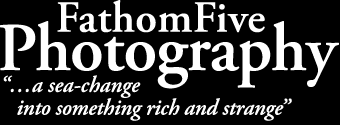
Cast of the UBC Opera in a performance of Puccini's "Gianni Schicchi". Chan Centre, UBC, Vancouver. Dress rehearsal, November 3 2009. Photo: Ken Bryant
For the theatrical photographer, the life-cycle of a play presents two very different opportunities for photography: the publicity shoot, and the production shoot.

Vincent Gale and Patricia Drake in the 2009 Pi Theatre / Persephone Theatre production of Carole Frechette's 'John and Beatrice', translated by John Murrell. Publicity shot. Photo: Ken Bryant
The publicity shoot provides the first advertising shots for the production, and takes place weeks before the opening. This is usually a relatively leisurely shoot, and the photographer has the advantages of bringing all of his studio equipment to bear: he has all the light he needs or can afford, and with it full control of ISO, depth of field and exposure length. But at this stage the production is in its infancy. There is a concept, provided by a script, but as yet no set, no costumes, no lighting beyond what the photographer provides. Shots are clear and sharp, noise-free, lots of technical punch but nowhere near yet the subtlety of a rehearsed production energized by a full production crew.
 Tetsuro Shige-matsu and Kevan Ohtsji in "After the Quake" by Haruki Mura-kami, adapted by Frank Galati, co-presented by Pi Theatre and Rumble Productions, November 19 - December 5, 2009 at Studio 16 in Vancouver. Dress rehearsal, November 19 2009. Photo: Ken Bryant
Tetsuro Shige-matsu and Kevan Ohtsji in "After the Quake" by Haruki Mura-kami, adapted by Frank Galati, co-presented by Pi Theatre and Rumble Productions, November 19 - December 5, 2009 at Studio 16 in Vancouver. Dress rehearsal, November 19 2009. Photo: Ken BryantThe production shoot is a dress rehearsal, usually the last before the opening. It's a photographer's dream in many ways: scores of lights, gelled and focussed, wielded by a lighting professional, and a cast with weeks spent living in their roles; freedom to roam the theatre with his camera and choose any angle that still allows him to stay out of everybody's way, a fly on the ceiling. The bad news is that all that beautiful light isn't very bright, and everybody's moving very very fast. Here equipment makes all the difference: a high ISO body and a fast lens are a requirement. It's here, too, that film can no longer compete with digital: no film available can match the ISO 6400 of my D3. Digital's other advantage is turn-around time: the production shoot occurs just before opening night, and if the shots are going to be out to the press in time to boost the box-office, they have to be in the publicist's hands in hours after the shoot.
